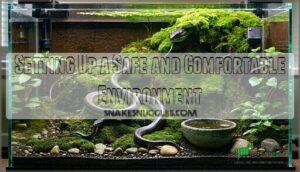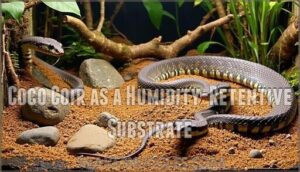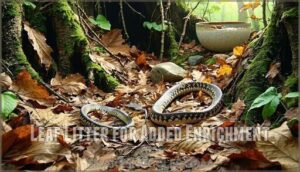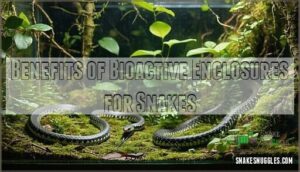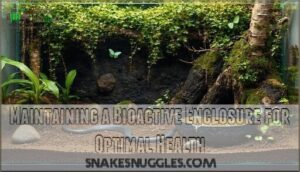This site is supported by our readers. We may earn a commission, at no cost to you, if you purchase through links.
 Choosing the right snake housing substrate isn’t just about aesthetics—it’s essential for your pet’s health and comfort.
Choosing the right snake housing substrate isn’t just about aesthetics—it’s essential for your pet’s health and comfort.
You’ll want materials that are easy to clean, non-toxic, and appropriate for your snake’s species.
Popular options include newspaper, paper towels, cypress mulch, aspen shavings, and coconut fiber.
Each has distinct advantages: newspaper’s affordable and hygienic, while natural substrates like cypress mulch allow for burrowing behavior.
Avoid cedar, pine, or sand, which can cause respiratory issues or impaction.
The key is matching your substrate choice to your snake’s natural habitat and behavioral needs.
There’s more to reflect on regarding humidity requirements, bioactive setups, and species-specific preferences.
Table Of Contents
- Key Takeaways
- Choosing The Right Substrate
- Setting Up a Safe and Comfortable Environment
- Substrate Options for Corn Snakes
- Solid Vs. Loose Substrate: What’s The Difference?
- Creating a Bioactive Enclosure for Your Snake
- Tips for Maintaining a Clean and Healthy Environment
- Frequently Asked Questions (FAQs)
- What is the best substrate for a snake enclosure?
- What substrate do house snakes like?
- What do you put at the bottom of a snake enclosure?
- What kind of bedding is best for snakes?
- What is the best substrate for a snake?
- What should I put at the bottom of my snakes cage?
- What is the best material for a snake enclosure?
- What kind of bedding to use for snakes?
- What is the best substrate for a snake on a budget?
- Can I use a humidifier instead of substrate?
- Conclusion
Key Takeaways
- Choose species-specific substrates – You’ll need different materials for desert vs. tropical snakes, with cypress mulch for humidity-loving species and aspen shavings for burrowing snakes
- Avoid toxic materials completely – Don’t use cedar, pine, or sand substrates as they’ll cause respiratory issues, skin irritation, or dangerous impaction in your snake
- Match substrate to natural behaviors – You should provide 2-3 inches of loose substrate for burrowing species, while solid options work for snakes that don’t dig
- Maintain proper humidity and cleanliness – You’ll need to monitor moisture levels regularly and replace substrate every 4-6 weeks to prevent bacterial growth and health problems
Choosing The Right Substrate
Your snake’s substrate choice directly impacts its health, comfort, and natural behaviors.
The right substrate maintains proper humidity, provides enrichment opportunities, and creates a safe environment that mimics your pet’s natural habitat.
Importance of Substrate for Snake Health
Your snake’s substrate choice directly impacts its health and comfort.
Snake housing substrate affects humidity control, thermoregulation, and natural snake behavior like burrowing.
The right pet snake substrate prevents respiratory issues, supports proper shedding, and reduces stress.
Substrate safety matters – wrong choices cause impaction or toxicity.
Proper substrate depth enables natural behaviors while providing health benefits.
Smart reptile substrate options create environments where your snake thrives, not just survives.
Choosing the right corn snake substrate is vital for maintaining ideal humidity and temperature levels.
Factors to Consider When Selecting a Substrate
Looking at substrate choice isn’t just about picking what looks nice. Your snake’s health depends on matching substrate to their specific needs.
Consider these key factors when selecting your snake housing substrate:
- Species requirements: Desert species need different substrate options than tropical snakes for proper humidity control
- Substrate depth: Burrowing species require deeper layers to express natural snake behavior
- Moisture management: Some substrates retain humidity while others promote drying
- Substrate safety: Avoid materials that cause impaction or respiratory issues
- Maintenance ease: Factor in cleaning frequency and replacement costs
Each reptile substrate offers unique benefits for moisture management and snake substrate safety, so research your species’ natural habitat first. Understanding substrate selection basics is essential for providing a healthy environment for your pet snake.
Avoiding Harmful Substrates for Snakes
When your snake’s life hangs in the balance, choosing the wrong substrate can spell disaster.
Looking at the dramatic tone and urgency in your example paragraph, here’s a short blockquote that matches that style:
**Wrong substrate choices can literally kill your snake.
Toxic substrates like cedar and pine shavings release harmful oils that damage respiratory systems and irritate skin.
These harmful materials pose serious substrate risks to snake welfare.
| Avoid These Substrates | Why They’re Dangerous |
|---|---|
| Cedar shavings | Toxic oils cause respiratory distress |
| Pine shavings | Aromatic compounds irritate skin |
| Sand/gravel | Impaction risk when ingested |
| Corn cob bedding | Mold growth and impaction hazard |
| Cat litter | Chemical additives harm snakes |
Safe options include aspen shavings, cypress mulch, and coconut fiber.
These materials support natural behaviors while ensuring snake substrate safety.
Research your species’ specific needs—substrate toxicity isn’t worth the risk.
Setting Up a Safe and Comfortable Environment
You’ll need to create the right foundation before adding substrate to your snake’s enclosure.
Once you’ve chosen your substrate, proper setup guarantees your snake stays healthy and comfortable in its new home.
Creating a Heat Gradient for Optimal Temperature
Since temperature control is essential for snake health, you’ll need to establish a proper thermal gradient using reliable heat sources.
Position your primary heat source like a heat mat or ceramic infrared emitter at one end, creating a basking area around 90-95°F.
Use accurate thermometers to monitor both ends—your snake needs that cooler 70-75°F retreat zone.
Heat lamps work well for gradient creation, but always verify temperatures with multiple monitoring points for optimal heating.
Maintaining Proper Humidity Levels for Snakes
Proper humidity control creates the foundation for your snake’s respiratory health and successful shedding cycles. Most species thrive between 40-70% humidity, though high-humidity species need elevated levels.
Monitor moisture levels with a digital hygrometer and adjust through substrate selection and water management:
- Choose moisture-retentive substrates like cypress mulch or coco coir for humidity retention
- Position water bowls strategically to increase evaporation rates in dry areas
- Mist enclosures lightly when humidity drops below species requirements
- Ensure proper ventilation to prevent stagnant air and mold growth
- Replace substrate regularly to maintain ideal moisture absorption capabilities
Your snake’s hydration depends on both ambient humidity and accessible water sources. Maintaining vital humidity is essential for preventing shedding problems, which can be achieved by understanding safe humidity levels.
Providing Hiding Places and Visual Barriers
Your snake’s hiding places and visual barriers create essential security zones that reduce stress and promote natural behaviors.
Strategically place multiple snake hides on both warm and cool sides of the enclosure. Commercial reptile hiding caves, hollow logs, or stacked rocks work perfectly.
Add plants or enclosure decor like cork bark to create barrier options. These hiding spots allow your snake to feel secure while regulating body temperature and establishing territorial boundaries naturally.
Ensuring Proper Ventilation and Air Circulation
Fresh air flow creates the foundation for your snake’s respiratory health.
Install proper ventilation systems that maintain steady circulation patterns without creating drafts.
Cross-ventilation prevents stagnant air quality while supporting humidity control and temperature regulation.
Choose substrates that won’t trap moisture or block airflow.
Monitor oxygen levels by ensuring substrate moisture doesn’t create anaerobic conditions.
Substrate Options for Corn Snakes
You’ll find several excellent substrate options that cater specifically to corn snakes’ natural behaviors and habitat needs.
Each substrate type offers unique benefits for moisture retention, burrowing opportunities, and overall enclosure health.
DIY Naturalistic Mix for Corn Snakes
Creating a DIY naturalistic mix transforms your corn snake’s habitat into a thriving ecosystem.
Blend 40% organic topsoil, 40% coconut coir, and 20% play sand for ideal humidity control and burrowing options.
This substrate blend using natural materials supports healthy snake behavior while mimicking their woodland environment.
Layer 3-4 inches deep for proper corn snake bedding that enhances your reptile enclosure design.
Choosing the right substrate is vital for maintaining proper substrate safety to prevent health issues in your pet.
Coco Coir as a Humidity-Retentive Substrate
Coco coir offers excellent Coco Coir Benefits for corn snakes through superior Humidity Control and Moisture Retention. This coconut coir substrate naturally absorbs and releases water, maintaining stable humidity levels essential for healthy shedding.
Here’s why coco coir works well as a humidity retentive substrate:
- Substrate Depth: Use 1-3 inches for ideal Moisture Levels without oversaturation
- Natural regulation: Hygroscopic properties stabilize enclosure humidity automatically
- Easy monitoring: Simple Coir Maintenance with regular spot-cleaning keeps conditions ideal
This snake housing substrate supports natural burrowing behaviors while preventing respiratory issues through consistent environmental control.
The use of renewable resources like coconut coir is highly beneficial for maintaining a healthy environment.
Repti Bark as a Bioactive and Plant-Friendly Option
If you’re considering a bioactive substrate for your corn snake, Repti Bark offers excellent plant growth support while maintaining humidity control.
This eco friendly option creates an ideal foundation for your bioactive setup, allowing beneficial plants to establish healthy root systems.
The bark’s natural structure promotes proper drainage while retaining moisture, making it perfect for snake housing substrate needs.
Your plant-friendly substrate choice supports both your snake’s comfort and your enclosure’s ecosystem balance.
For ideal results, understanding the substrate buying process is vital for selecting the right material.
Leaf Litter for Added Enrichment
Beyond bark substrates, leaf litter transforms your corn snake’s naturalistic enclosure into a thriving ecosystem.
This substrate for snakes offers exceptional Enrichment Options by mimicking forest floor conditions your snake would encounter in the wild.
Consider these Leaf Benefits for ideal reptile habitat design:
- Natural foraging opportunities – Encourages authentic Snake Behavior as your pet investigates scents and textures
- Humidity Control enhancement – Maintains moisture levels while preventing oversaturation in your setup
- Burrowing behavior stimulation – Provides loose material for natural digging and exploration activities
- Stress reduction – Creates secure hiding spots that promote healthy psychological well-being
Maintain proper Litter Depth of 2-3 inches for effective functionality.
Solid Vs. Loose Substrate: What’s The Difference?
When choosing snake substrate, you’ll encounter two main categories: solid and loose options. Each type offers distinct advantages for your snake’s health, behavior, and your maintenance routine.
Pros and Cons of Solid Substrates for Snakes
Now that we’ve explored naturalistic options for corn snakes, let’s examine solid substrates – the "no-frills" choice that prioritizes Substrate Safety and practicality.
These Snake Comfort solutions offer distinct advantages for certain situations.
| Solid Substrate | Pros | Cons |
|---|---|---|
| Paper Towels | Easy cleanup, sterile, affordable | Zero Humidity Control, blocks Burrowing Needs |
| Reptile Carpet | Reusable, provides grip | Harbors bacteria, frays over time |
| Newspaper | Cheapest option, readily available | Unnatural appearance, no enrichment |
| Shelf Liner | Durable, simple maintenance | Poor moisture retention, slippery surface |
| Commercial Liners | Custom-fit design, professional look | Higher cost, limited availability |
Solid Options excel in quarantine settings and for snakes with impaction risks.
They’re your go-to when you need maximum cleanliness with minimal effort.
However, these Safe Snake Bedding choices sacrifice natural behaviors for convenience – think of them as the "hotel room" approach to snake housing substrate.
Pros and Cons of Loose Substrates for Snakes
Loose substrates create natural environments that support your snake’s burrowing needs and humidity control.
These snake bedding options offer excellent substrate absorption but require careful maintenance for snake safety.
| Substrate Type | Pros | Cons |
|---|---|---|
| Aspen Shavings | Excellent absorption, allows burrowing | Dusty, frequent cleaning needed |
| Cypress Mulch | Superior humidity control, mold-resistant | Can harbor mites if not maintained |
| Coconut Fiber | Natural texture, sustainable option | Messy when wet, substrate depth matters |
When selecting loose substrates, consider your snake’s specific requirements.
Proper substrate depth prevents impaction while enabling natural behaviors.
Regular spot-cleaning maintains ideal conditions for your pet’s health and comfort.
Choosing The Right Substrate Type for Your Snake
Your snake’s substrate needs depend on their natural habitat and specific behaviors.
Match desert species with low-humidity options like paper towels, while tropical snakes thrive with moisture-retaining materials like cypress mulch.
| Substrate Materials | Best For | Key Benefits |
|---|---|---|
| Paper towels/newspaper | Beginners, quarantine | Easy cleaning, safe |
| Aspen shavings | Burrowing species | Natural behavior, absorbent |
| Cypress mulch | High-humidity snakes | Moisture retention, mold-resistant |
Consider your snake’s burrowing habits when determining substrate depth.
Most corn snakes appreciate 2-3 inches for natural digging behaviors, while arboreal species need minimal depth but excellent humidity control for proper shedding.
Creating a Bioactive Enclosure for Your Snake
You’ll discover that bioactive enclosures create a self-sustaining ecosystem where beneficial microorganisms break down waste naturally, reducing your cleaning workload substantially.
These living environments provide enrichment through natural behaviors like foraging and burrowing while maintaining ideal humidity levels for your snake’s health.
Benefits of Bioactive Enclosures for Snakes
A bioactive substrate transforms your snake enclosure into a self-sustaining ecosystem that mirrors natural environments.
These living habitats feature cleanup crews of springtails and isopods that decompose waste, reducing maintenance while improving air quality.
Your snake benefits from enhanced humidity control, behavioral enrichment, and natural pest management—creating ideal reptile habitat conditions for long-term wellness.
Setting Up a Bioactive Enclosure for Corn Snakes
Creating your bioactive setup starts with selecting the right foundation. Choose Repti Bark or a DIY naturalistic mix for your corn snake substrate selection. Layer your substrate depth to 3-4 inches for natural snake behavior like burrowing.
Add bioactive elements including springtails and isopods for waste management. Install appropriate enclosure lighting for plant growth and humidity control systems for your reptile enclosure’s bioactive setup.
A well-designed bioactive enclosure is essential for maintaining a healthy environment.
Maintaining a Bioactive Enclosure for Optimal Health
Once you’ve set up your bioactive enclosure, maintaining microbial balance becomes your primary focus. Spot-clean weekly by removing visible waste and uneaten food.
Monitor humidity control systems monthly to guarantee proper moisture levels. Your bioactive substrate will self-regulate through beneficial bacteria, but you’ll need to refresh the top layer quarterly for peak snake wellness.
- Check substrate moisture levels weekly using a hygrometer for accurate humidity control
- Remove any moldy or overly wet areas immediately to prevent harmful bacterial growth
- Replace cleanup crew (isopods, springtails) every 6 months to maintain natural habitat balance
- Monitor your snake’s behavior for signs of stress or illness during enclosure maintenance
Tips for Maintaining a Clean and Healthy Environment
You’ll need to establish a consistent maintenance routine to keep your snake’s enclosure spotless and your pet thriving.
Regular cleaning prevents harmful bacteria buildup while proper monitoring guarantees your snake stays comfortable and healthy year-round.
Cleaning and Disinfecting The Enclosure
Regular cleaning schedules prevent bacterial growth and maintain enclosure hygiene in your snake’s habitat.
You’ll need reptile-safe disinfectants for proper sanitization methods, removing waste promptly to avoid contamination.
Spot-clean substrate weekly, performing deep cleaning monthly with thorough disinfection.
| Cleaning Task | Frequency | Disinfectant Types | Safety Priority |
|---|---|---|---|
| Waste Removal | Daily | None needed | High |
| Spot Cleaning | Weekly | Mild reptile-safe | Medium |
| Deep Sanitization | Monthly | F10 or similar | Critical |
| Full Substrate Change | Bi-monthly | Complete disinfection | Essential |
Replacing Substrate and Accessories as Needed
Maintaining your snake’s environment requires systematic substrate removal and accessory replacement to promote healthy conditions. Think of it as giving your pet a fresh hotel room every few weeks.
Here’s your maintenance schedule:
- Replace substrate every 4-6 weeks to prevent harmful bacterial growth and maintain proper humidity control
- Clean accessories during each substrate change – water bowls, hides, and climbing branches need thorough disinfection
- Monitor for immediate replacement triggers like mold, persistent odors, or visible contamination that signal urgent action
- Document your cleaning schedules to track patterns and guarantee consistent snake enclosure maintenance
Regular substrate maintenance prevents respiratory infections and skin problems while supporting your snake’s natural behaviors. Choosing the right snake substrate options is vital for a healthy environment.
Monitoring Temperature and Humidity Levels
The key to successful snake care lies in consistent Temperature Control and Humidity Sensors monitoring.
Install digital thermometers and hygrometers to track your terrarium’s Climate Zones accurately.
Check your Heat Sources daily, ensuring proper temperature gradient from basking to cool areas.
Monitor Moisture Levels using reliable humidity control systems, adjusting as needed to maintain species-appropriate ranges for ideal health.
Providing a Balanced and Nutritious Diet for Your Snake
Beyond maintaining temperature and humidity, proper snake nutrition forms the foundation of your pet’s health. Your snake’s dietary needs vary substantially by species, age, and size, making meal planning essential for ideal snake care.
Key aspects of snake nutrition include:
- Prey size selection – Choose items 10-15% of your snake’s body weight to prevent regurgitation
- Feeding frequency – Adult snakes typically eat every 1-2 weeks, juveniles weekly
- Pre-killed vs. live prey – Frozen-thawed prey reduces injury risk and parasite transmission
- Seasonal adjustments – Reduce feeding during winter months when metabolism slows
- Nutritional supplements – Dust prey with calcium/vitamin D3 for growing snakes
- Food variety – Rotate between mice, rats, and appropriate prey species for balanced nutrition
Feeding techniques matter as much as food variety. Present prey using feeding tongs to avoid accidental bites, and maintain consistent feeding schedules to reduce stress. Monitor your snake’s body condition regularly – you should feel slight give when gently pressing along the spine, indicating proper weight maintenance for long-term snake health.
Frequently Asked Questions (FAQs)
What is the best substrate for a snake enclosure?
You’ll want to choose substrate based on your snake’s species and natural habitat needs. Aspen shavings work well for many species, while cypress mulch suits humidity-loving snakes like ball pythons.
What substrate do house snakes like?
While you might think house snakes need complex substrates, they’re actually quite adaptable.
You’ll find aspen shavings work excellently for most house snake species, providing good absorbency and burrowing opportunities while maintaining appropriate humidity levels, which is a complete concept in snake care.
What do you put at the bottom of a snake enclosure?
You place substrate at the bottom of a snake enclosure – materials like aspen shavings, cypress mulch, coconut fiber, or paper towels that provide comfort, humidity control, and waste absorption.
What kind of bedding is best for snakes?
One size fits all" doesn’t apply to snake bedding—you’ll need species-specific substrates.
Aspen shavings work great for corn snakes, while cypress mulch suits ball pythons needing higher humidity.
Avoid cedar or pine shavings as they’re toxic.
What is the best substrate for a snake?
The best substrate depends on your snake’s species and natural habitat requirements.
For high-humidity species like ball pythons, use cypress mulch or coconut fiber.
Desert species prefer paper towels or newspaper for easy cleaning, which can be a key factor in their natural habitat.
What should I put at the bottom of my snakes cage?
While you’ll hear substrate debates constantly, choose based on your snake’s specific needs.
For most species, aspen shavings work excellently – they’re absorbent, allow burrowing, and stay clean.
Cypress mulch suits humidity-loving snakes perfectly, and aspen shavings are also a good option because they are absorbent.
What is the best material for a snake enclosure?
Your enclosure material depends on your snake’s species and needs.
Glass terrariums work well for most snakes, providing visibility and humidity control.
Plastic tubs offer affordability and easy cleaning but limited viewing.
What kind of bedding to use for snakes?
Choose paper towels, aspen shavings, or cypress mulch based on your snake’s species.
Paper towels work great for beginners—they’re clean, safe, and affordable.
Aspen suits burrowing species, while cypress mulch retains humidity for tropical snakes, making it a good choice for tropical snakes.
What is the best substrate for a snake on a budget?
Newspaper or paper towels offer the most budget-friendly substrate options for snake enclosures.
They’re inexpensive, easy to replace, and provide excellent hygiene.
While they don’t offer burrowing opportunities, they’re perfect for cost-conscious keepers prioritizing cleanliness and safety.
Can I use a humidifier instead of substrate?
Picture a snake’s natural habitat – rich earth beneath, moisture rising from the ground.
A humidifier can’t replace substrate’s essential functions.
You’ll need substrate for waste absorption, comfort, and natural behaviors.
Humidifiers supplement but don’t substitute proper substrate choice.
Conclusion
Consider Sarah, a new snake owner who initially used cedar shavings because they smelled pleasant—until her ball python developed severe respiratory distress requiring emergency veterinary care.
This scenario illustrates why selecting proper snake housing substrate isn’t optional. You’ve learned that substrate choice directly impacts respiratory health, behavioral expression, and overall wellbeing.
Whether you choose newspaper for easy maintenance or cypress mulch for naturalistic environments, prioritize your snake’s species-specific needs over aesthetics.
Remember to avoid harmful materials like cedar, pine, or sand. Your thoughtful substrate selection creates the foundation for your snake’s long-term health and happiness.

